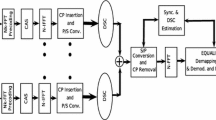Abstract
A simple approach for adaptive interference suppression for the downlink (base-to-mobile link) of a direct sequence (DS) based cellular communication system is presented. The base station transmits the sum of the signals destined for the different mobiles, typically attempting to avoid intra-cell interference by employing orthogonal spreading sequences for different mobiles. However, the signal reaching any given mobile passes through a dispersive channel, thus destroying the orthogonality. In this paper, we propose an adaptive linear equalizer at the mobile that reduces interference by approximately restoring orthogonality. The adaptive equalizer uses the pilot's spreading sequence (which observes the same channel as the spreading sequence for the desired mobile) as training. Simulation results for the linear Minimum Mean Squared Error (MMSE) equalizer are presented, demonstrating substantial performance gains over the RAKE receiver. Long spreading sequences (which vary from symbol to symbol) are employed, so that the equalizer adapts not to the time-varying spreading sequences, but to the slowly varying downlink channel. Since the inter-cell interference from any other base station also has the structure of many superposed signals passing through a single channel, the adaptive equalizer can also suppress inter-cell interference, with the tradeoff between suppression of intra- and inter-cell interference and noise enhancement depending on their impact on the Mean Squared Error (MSE).
Similar content being viewed by others
References
A. Klein, “Data Detection Algorithms Specially Designed for the Downlink of CDMA Mobile Radio Systems,” in Proc. IEEE International Vehicular Technology Conference, VTC'97, Phoenix, AZ, May 1997, pp. 203-207.
G.E. Bottomley, “Optimizing the RAKE Receiver for the CDMA Downlink,” in Proc. IEEE International Vehicular Technology Conference, VTC'93, 1993, pp. 742-745.
C.D. Frank and E. Visotsky, “Adaptive Interference Suppression for Direct-Sequence CDMA Systems with Long Spreading Codes,” in Proc. 36th Annual Allerton Conference on Communication, Control and Computing, Monticello, IL, Sept. 1998.
I. Ghauri and D.T.M. Slock, “Linear Receivers for the DS-CDMA Downlink Exploiting Orthogonality of Spreading Sequences,” in Proc. 32nd Asilomar Conference on Signals, Systems and Computers, Asilomar, CA, Nov. 1998, pp. 650-654.
S. Werner and J. Lilleberg, “Downlink Channel Decorrelation in CDMA Systems with Long Codes,” in Proc. IEEE International Vehicular Technology Conference, VTC'99, Houston, TX, May 1999, pp. 1614-1617.
M.J. Heikkilä, P. Komulainen, and J. Lilleberg, “Interference Suppression in CDMA Downlink Through Adaptive Channel Equalization,” in Proc. IEEE International Vehicular Technology Conference, VTC'99—Fall, Amsterdam, Netherlands, Sept. 1999, pp. 978-982.
P. Komulainen, M.J. Heikkilä, and J. Lilleberg, “Adaptive Channel Equalization and Interference Suppression for CDMA Downlink,” in Proc. IEEE 6th International Symposium on Spread-Spectrum Techniques and Applications, ISSSTA 2000, NJ, Sept. 2000, pp. 363-367.
T.P. Krauss and M.D. Zoltowski, “Chip-Level MMSE Equalization at the Edge of the Cell,” in Proc. IEEE Wireless Communications and Networking Conference, WCNC 2000, Chicago, IL, Sept. 2000, pp. 23-28.
K. Hooli, M. Latva-aho, and M. Juntti, “Multiple Access Interference Suppression with Linear Chip Equalizers in WCDMA Downlink Receivers,” in Proc. IEEE Global Telecommunications Conference, Globecom, Rio de Janeiro, Brazil, Dec. 1999, pp. 467-471.
F. Petre, M. Moonen, M. Engels, B. Gyselinckx, and H.D. Man, “Pilot-Aided Adaptive Chip Equalizer Receiver for Interference Suppression in DS-CDMA Forward Link,” in Proc. IEEE International Vehicular Technology Conference, VTC—Fall, Boston, MA, Sept. 2000.
G.E. Bottomley, T. Ottosson, and Y.E. Wang, “A Generalized RAKE Receiver for Interference Suppression,” IEEE Journal on Selected Areas in Communications, vol. 18, Aug. 2000, pp. 1536-1545.
S. Chowdury, M.D. Zoltowski, and J.S. Goldstein, “Reduced-Rank Adaptive MMSE Equalization for High-Speed CDMA Forward Link with Sparse Multipath Channels,” in Proc. 38th Annual Allerton Conference on Communication, Control and Computing, Monticello, IL, Sept. 2000.
U. Madhow and M. Honig, “MMSE Interference Suppression for Direct-Sequence Spread Spectrum CDMA,” IEEE Transactions on Communications, vol. 32, Dec. 1994, pp. 3178-3188.
S. Haykin, Adaptive Filter Theory, Englewood Cliff, NJ: Prentice Hall, 1996.
J.G. Proakis, Digital Communications, New York, NY: McGraw-Hill, 1995.
Author information
Authors and Affiliations
Rights and permissions
About this article
Cite this article
Frank, C.D., Visotsky, E. & Madhow, U. Adaptive Interference Suppression for the Downlink of a Direct Sequence CDMA System with Long Spreading Sequences. The Journal of VLSI Signal Processing-Systems for Signal, Image, and Video Technology 30, 273–291 (2002). https://doi.org/10.1023/A:1014015413513
Published:
Issue Date:
DOI: https://doi.org/10.1023/A:1014015413513




